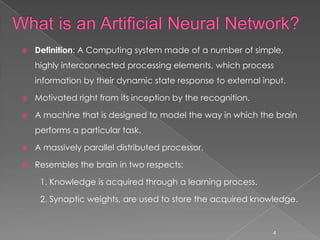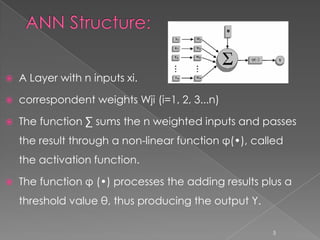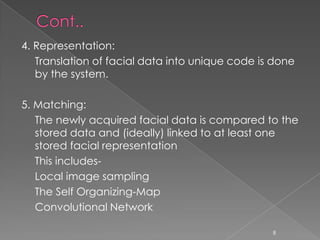Face recognition using artificial neural network
- 1. PRESENTED BY:- GUIDED BY:- SUMEET S. KAKANI PROF. V. M. UMALE 1
- 2. Introduction What is an Artificial Neural Network? ANN Structure System Overview Local image sampling The Self Organizing-Map Perceptron learning rule Convolutional Network System details Implementation Applications Conclusion References 2
- 3. 1. Why face recognition? Face Recognition systems enhance security, provide secure access control, and protect personal privacy Improvement in the performance and reliability of face recognition No need to remember any passwords or carry any ID 2. Why neural network? Adaptive learning: An ability to learn how to do tasks Self-Organization: An ANN can create its own organisation Remarkable ability to derive meaning from complicated or imprecise data 3
- 4. Definition: A Computing system made of a number of simple, highly interconnected processing elements, which process information by their dynamic state response to external input. Motivated right from its inception by the recognition. A machine that is designed to model the way in which the brain performs a particular task. A massively parallel distributed processor. Resembles the brain in two respects: 1. Knowledge is acquired through a learning process. 2. Synaptic weights, are used to store the acquired knowledge. 4
- 5. A Layer with n inputs xi. correspondent weights Wji (i=1, 2, 3...n) The function ∑ sums the n weighted inputs and passes the result through a non-linear function φ(•), called the activation function. The function φ (•) processes the adding results plus a threshold value θ, thus producing the output Y. 5
- 6. a) Processing units Receive input The adjustment of the weights Three types of units: 1. input units 2. hidden units 3. output units During operation, units can be updated either synchronously or asynchronously. b) Connections between units n Y(t) = φ( ∑ wij(t) Xj(t) + θ) j=1 c) Transfer Function: The behavior of an ANN depends on both the weights and the transfer function that is specified for the units. This function typically falls into one of two categories: Linear : the output activity is proportional to the total weighted output. Threshold: the output is set at one of two levels, depending on whether the total input is greater than or less than some threshold value. 6
- 7. Following are the basic processes that are used by the system to capture and compare images: 1. Detection: Recognition software searches the field of view of a video camera for faces. Once the face is in view, it is detected within a fraction of a second . 2. Alignment: Once a face is detected, the head's position, size and pose is the first thing that is determined. 3. Normalization: The image of the head is scaled and rotated so that it can be registered and mapped into an appropriate size and pose. 7
- 8. 4. Representation: Translation of facial data into unique code is done by the system. 5. Matching: The newly acquired facial data is compared to the stored data and (ideally) linked to at least one stored facial representation This includes- Local image sampling The Self Organizing-Map Convolutional Network 8
- 9. Figure : A representation of the local image sampling process. • We have evaluated two different methods of representing local image samples. • In each method a window is scanned over the image as shown in figure. 9
- 10. Used to reduce the dimensions of the image vector Self-Organizing Map(SOM), is an unsupervised learning process, which learns the distribution of a set of patterns without any class information. Unsupervised learning: a) No external teacher and is based upon only local information. b) It is also referred to as self-organization unsupervised learning. The basic SOM consists of: I) A 2 dimensional lattice L of neurons. II) Each neuron ni belongs to L has an associated codebook vector μi belongs to Rn. III) The lattice is either rectangular or hexagonal as shown in figure 10
- 11. Figure: Rectangular and hexagonal lattice • Self-organizing maps learn both the distribution and topology of the input vectors they are trained on. • Here a self-organizing feature map network identifies a winning neuron i using the same procedure as employed by a competitive layer. • However, instead of updating only the winning neuron, all neurons within a certain neighborhood of the winning neuron are updated 11
- 12. Perceptrons are trained on examples of desired behavior. The desired behavior can be summarized by a set of input, output pairs as: p1t1, p2t2,………….. pQtQ Where p is an input to the network and t is the corresponding correct (target) output. The perceptron learning rule can be written more succinctly in terms of the error e = t - a, and the change to be made to the weight vector Δw: Case 1: If e = 0, then make a change Δw equal to 0. Case 2: If e = 1, then make a change Δw equal to p T. Case 3: If e = -1, then make a change Δw equal to -p T. 12
- 13. Figure : A typical convolutional network. 13
- 14. Automatically synthesize simple problem specific feature extractor from training data. Feature detectors applied everywhere. Features get progressively more global and invariant. The whole system is trained “end-to-end” with gradient based method to minimize a global loss function. Integrate segmentation, feature extraction, and invariant classification in one stretch. 14
- 15. 1. Convolutional Mechanism Capable of extracting similar features in different places in the image. Shifting the input only shifts the feature map (robust to shift). 2. Subsampling Mechanism The exact positions of the extracted features are not important. Only relative position of a feature to another feature is relevant. Reduce spatial resolution – Reduce sensitivity to shift and distortion. 15
- 16. For the images in the training set, a fixed size window is stepped over the entire image. As shown in earlier figure and local image samples are extracted at each step. A self-organizing map is trained on the vectors from the previous stage 16
- 17. The same window as in the first step is stepped over all of the images in the training and test sets. The local image samples are passed through the SOM at each step, thereby creating new training and test sets in the output space created by the self-organizing map. A convolutional neural network is trained on the newly created training set 17
- 18. Training: Testing: 18
- 19. Law Enforcement: Minimizing victim trauma by narrowing mug shot searches, Verifying identify for court records, and comparing school Surveillance camera Images to known child molesters. Security/Counter terrorism: Access control, comparing surveillance images to Known terrorists. Day Care: Verify identity of individuals picking up the children. Missing Children/Runaways Search surveillance images and the internet for missing children and runaways. Residential Security: Alert homeowners of approaching personnel. Healthcare: Minimize fraud by verifying identity. Banking: Minimize fraud by verifying identity. 19
- 20. There are no explicit three-dimensional models in our system, however we have found that the quantized local image samples used as input to the convolutional network represent smoothly changing shading patterns. Higher level features are constructed from these building blocks in successive layers of the convolutional network. In comparison with the eigenfaces approach, we believe that the system presented here is able to learn more appropriate features in order to provide improved generalization. 20
- 21. 1. Steve Lawrence, C. Lee Giles , “Face Recognition: A Convolutional Neural Network Approach”, IEEE transaction, St. Lucia, Australia. 2. David a brown, Ian craw, Julian lewthwaite, “Interactive Face retrieval using self organizing maps-A SOM based approach to skin detection with application in real time systems”, IEEE 2008 conference, Berlin, Germany. 3. Shahrin Azuan Nazeer, Nazaruddin Omar' and Marzuki Khalid, “Face Recognition System using Artificial Neural Networks Approach”, IEEE - ICSCN 2007, MIT Campus, Anna University, Chennai, India. Feb. 22-24, 2007. pp.420-425. 4. M. Prakash and M. Narasimha Murty, “Recognition Methods and Their Neural- Network Models”, IEEE TRANSACTIONS ON NEURAL NETWORKS, VOL. 8, NO. 1, JANUARY 2005. 5. E. Oja, “Neural networks, principal components and subspaces”, Int. J. Neural Syst., vol. 1, pp. 61–68, 2004. 21
- 22. THANK YOU 22






















